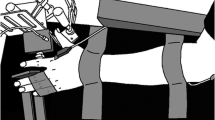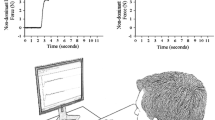Abstract
The purpose of this study was to compare control of force and modulation of agonist muscle activity of young and older adults when the amount of visual feedback was varied at two different force levels. Ten young adults (25 years ± 4 years, 5 men and 5 women) and ten older adults (71 years ± 5 years, 4 men and 6 women) were instructed to accurately match a constant target force at 2 and 30% of their maximal isometric force with abduction of the index finger. Each trial lasted 35 s, and the amount of visual feedback was varied by changing the visual angle at 0.05, 0.5, and 1.5°. Each subject performed three trials for each visual angle condition. Force variability was quantified as the standard deviation and coefficient of variation (CV) of force. Modulation of the agonist muscle activity was quantified as the normalized power spectrum density of the EMG signal recorded from two pairs of bipolar electrodes placed on the first dorsal interosseus muscle. The frequency bands of interest were between 5 and 100 Hz. There were significant age-associated differences in force control with changes in the amount of visual feedback. The CV of force did not change with visual angle for young adults, whereas it increased for older adults. Although older adults exhibited similar CV of force to young adults at 0.05° (5.95 ± 0.67 vs. 5.47 ± 0.5), older adults exhibited greater CV of force than young adults at 0.5° (8.49 ± 1.34 vs. 5.05 ± 0.5) and 1.5° (8.23 ± 1.12 vs. 5.49 ± 0.6). In addition, there were age-associated differences in the modulation of the agonist muscle activity. Young adults increased normalized power in the EMG signal from 13 to 60 Hz with an increase in visual angle, whereas older adults did not. These findings suggest that greater amount of visual information may be detrimental to the control of a constant isometric contraction in older adults, and this impairment may be due to their inability to effectively modulate the motor neuron pool of the agonist muscle.




Similar content being viewed by others
References
Baweja HS, Patel BK, Martinkewiz JD, Vu J, Christou EA (2009) Removal of visual feedback alters muscle activity and reduces force variability during constant isometric contractions. Exp Brain Res 197:35–47
Baweja HS, Kennedy DM, Vu J, Vaillancourt DE, Christou EA (2010) Greater amount of visual feedback decreases force variability by reducing force oscillations from 0 to 1 and 3 to 7 Hz. Eur J Appl Physiol 108:935–943
Brown P (2000) Cortical drives to human muscle: the piper and related rhythms. Prog Neurobiol 60:97–108
Carlton LG (1992) Visual processing time and the control of movement. In: Proteau L, Elliott D (eds) Vision and motor control. Elsevier, Amsterdam, pp 3–31
Chao E, An KN, Cooney WP, Linschied R (1989) Biomechanics of the hand. A basic research study. World Scientific Publishing, Teaneack
Christou EA (2005) Visual feedback attenuates force fluctuations induced by a stressor. Med Sci Sports Exerc 37:2126–2133
Christou EA, Carlton LG (2001) Old adults exhibit greater motor output variability than young adults only during rapid discrete isometric contractions. J Gerontol A Biol Sci Med Sci 56:B524–B532
Christou EA, Neto O (2010) Identification of oscilations in muscle activity from surface EMG: reply to Halliday and Farmer. J Neurophysiol 103:3548–3549
Christou EA, Tracy BL (2005) Aging and motor output variability. In movement system variability. Human Kinetics, Champaign
Christou EA, Jakobi JM, Critchlow A, Fleshner M, Enoka RM (2004) The 1–2 Hz oscillations in muscle force are exacerbated by stress, especially in older adults. J Appl Physiol 97:225–235
Coombes SA, Corcos DM, Sprute L, Vaillancourt DE (2010) Selective regions of the visuomotor system are related to gain-induced changes in force error. J Neurophysiol 103:2114–2123
Crossman ER, Goodeve PJ (1983) Feedback control of hand-movement and Fitts’ law. Q J Exp Psychol A 35:251–278
Elliott D, Helsen WF, Chua R (2001) A century later: Woodworth’s (1899) two-component model of goal-directed aiming. Psychol Bull 127:342–357
Enoka RM, Christou EA, Hunter SK, Kornatz KW, Semmler JG, Taylor AM, Tracy BL (2003) Mechanisms that contribute to differences in motor performance between young and old adults. J Electromyogr Kinesiol 13:1–12
Farina D, Merletti R, Enoka RM (2004) The extraction of neural strategies from the surface EMG. J Appl Physiol 96:1486–1495
Green SB, Salkind NJ (2002) Using SPSS for the windows and macintosh: analyzing and understanding data. Prentice Hall, Upper Saddle River
Homma T, Sakai T (1991) Ramification pattern of intermetacarpal branches of the deep branch (ramus profundus) of the ulnar nerve in the human hand. Acta Anat (Basel) 141:139–144
Kennedy DM, Baweja HS, Vaillancourt DE, Christou EA (2009) Time onset and amplitude of force drift varies with force level during low-intensity constant isometric contractions. In: Proceedings of the society of neuroscience, Chicago
Kotecha A, Spratt A, Viswanathan A (2008) Visual function and fitness to drive. Br Med Bull 87:163–174
Li S, Yasuda N (2007) Forced ventilation increases variability of isometric finger forces. Neurosci Lett 412:243–247
Li ZM, Pfaeffle HJ, Sotereanos DG, Goitz RJ, Woo SL (2003) Multi-directional strength and force envelope of the index finger. Clin Biomech (Bristol, Avon) 18:908–915
Lord SR (2006) Visual risk factors for falls in older people. Age Ageing 35:42–45
Miall RC, Weir DJ, Stein JF (1993) Intermittency in human manual tracking tasks. J Mot Behav 25:53–63
Milham MP, Erickson KI, Banich MT, Kramer AF, Webb A, Wszalek T, Cohen NJ (2002) Attentional control in the aging brain: insights from an fMRI study of the stroop task. Brain Cogn 49:277–296
Myers LJ, Lowery M, O’Malley M, Vaughan CL, Heneghan C, ClairGibson A, Harley YX, Sreenivasan R (2003) Rectification and non-linear preprocessing of EMG signals for cortico-muscular analysis. J Neurosci Methods 124:157–165
Neto OP, Christou EA (2010) Rectification of the EMG signal impairs the identification of oscillatory input to the muscle. J Neurophysiol 103:1093–1103
Ofori E, Samson JM, Sosnoff JJ (2010) Age-related differences in force variability and visual display. Exp Brain Res 203:299–306
Oldfield RC (1971) The assessment and analysis of handedness: the Edinburgh inventory. Neuropsychologia 9:97–113
Prakash RS, Erickson KI, Colcombe SJ, Kim JS, Voss MW, Kramer AF (2009) Age-related differences in the involvement of prefrontal cortex in attentional control. Brain Cogn 71:328–335
Prodoehl J, Vaillancourt DE (2010) Effects of visual gain on force control at the elbow and ankle. Exp Brain Res 200:67–79
Schiffman SS (2007) Critical illness and changes in sensory perception. Proc Nutr Soc 66:331–345
Schiffman JM, Luchies CW, Richard LG, Zebas CJ (2002) The effects of age and feedback on isometric knee extensor force control abilities. Clin Biomech 6:486–493
Schoffelen JM, Oostenveld R, Fries P (2005) Neuronal coherence as a mechanism of effective corticospinal interaction. Science 308:111–113
Slifkin AB, Vaillancourt DE, Newell KM (2000) Intermittency in the control of continuous force production. J Neurophysiol 84:1708–1718
Sosnoff JJ, Newell KM (2006a) Aging, visual intermittency, and variability in isometric force output. J Gerontol B Psychol Sci Soc Sci 61:P117–P124
Sosnoff JJ, Newell KM (2006b) Information processing limitations with aging in the visual scaling of isometric force. Exp Brain Res 170:423–432
Sosnoff JJ, Newell KM (2007) Are visual feedback delays responsible for aging-related increases in force variability? Exp Aging Res 33:399–415
Taylor AM, Christou EA, Enoka RM (2003) Multiple features of motor-unit activity influence force fluctuations during isometric contractions. J Neurophysiol 90:1350–1361
Tracy BL (2007a) Force control is impaired in the ankle plantarflexors of elderly adults. Eur J Appl Physiol 101:629–636
Tracy BL (2007b) Visuomotor contribution to force variability in the plantarflexor and dorsiflexor muscles. Human Mov Sci 26:796–807
Tracy BL (2009) Contributions of visuomotor processing to force variability in human aging. In: Shinohara M (ed) Advances in neuromuscular physiology of motor skills and muscle fatigue. Research Signpost, Kerala, pp 39–63
Tracy BL, Dinenno DV, Jorgensen B, Welsh SJ (2007) Aging, visuomotor correction, and force fluctuations in large muscles. Med Sci Sports Exerc 39:469–479
Vaillancourt DE, Haibach PS, Newell KM (2006) Visual angle is the critical variable mediating gain-related effects in manual control. Exp Brain Res 173:742–750
Vaillancourt DE, Larsson L, Newell KM (2002) Time-dependent structure in the discharge rate of human motor units. Clin Neurophysiol 13:1325–1338
Vaillancourt DE, Russell DM (2002) Temporal capacity of short-term visuomotor memory in continuous force production. Exp Brain Res 145:275–285
Van der Lubbe R, Verleger R (2002) Aging and the Simon task. Psychophysiology 39:100–110
Welsh SJ, Dinenno DV, Tracy BL (2007a) Variability of quadriceps femoris motor neuron discharge and muscle force in human aging. Exp Brain Res 179:219–233
Welsh TN, Higgins L, Elliott D (2007b) Are there age-related differences in learning to optimise speed, accuracy and energy expenditure? Hum Mov Sci 26:892–912
Acknowledgments
The authors would like to acknowledge the help of Jonathan Leake with computer programming, Harsimran Baweja with data collection, and Osmar Pinto Neto with data analysis. Supported by R01 AG031769 to E. A. Christou.
Author information
Authors and Affiliations
Corresponding author
Rights and permissions
About this article
Cite this article
Kennedy, D.M., Christou, E.A. Greater amount of visual information exacerbates force control in older adults during constant isometric contractions. Exp Brain Res 213, 351–361 (2011). https://doi.org/10.1007/s00221-011-2777-x
Received:
Accepted:
Published:
Issue Date:
DOI: https://doi.org/10.1007/s00221-011-2777-x




